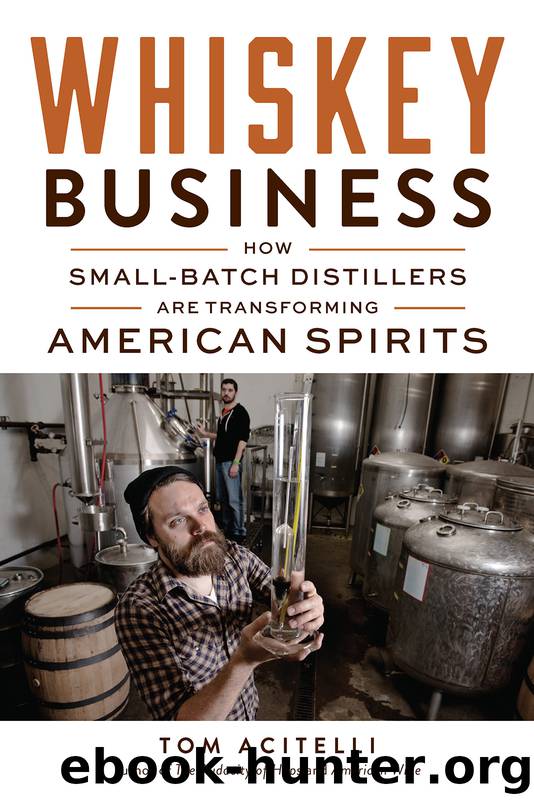Whiskey Business by Tom Acitelli

Author:Tom Acitelli
Language: eng
Format: epub
Publisher: Chicago Review Press
Published: 2017-06-28T04:00:00+00:00
CRAFT VS. CRAFTY
1996–2000|Manhattan—Bra, Italy
Shortly after 7:00 PM Eastern time on Sunday, October 13, 1996, the sonorously smooth voice and chiseled-chin good looks of Stone Phillips introduced eight million households to the next segment of Dateline, a four-year-old news show on NBC that broadcast out of the network’s Rockefeller Center headquarters in Midtown Manhattan. Dateline had debuted as a Tuesday-only show but had quickly spread to four nights, including this Sunday edition that was meant to go head-to-head with CBS’s 60 Minutes. It had yet to come anywhere close to besting that venerable program’s numbers, having tripped out of the gate with a disgraceful 1992 segment in which Dateline got caught rigging the fuel tanks of General Motors pickup trucks to explode to prove the vehicles were unsafe. The show’s marquee names, including Tom Brokaw, Jane Pauley, and Bryant Gumbel, kept Dateline afloat, and its documentary-like, confrontational style was eventually seen as something almost entirely new in primetime news, a precursor even to reality TV. Like spectators at a racetrack, those millions of households could not help but tune in to perhaps catch the next wreck.
On this particular autumn Sunday, the wreck would be craft beer—and the impact of the collision would reverberate down through the next decades into small-batch spirits. For now, the driver was Jim Koch, the cofounder and chairman of the Boston Beer Company, the concern he had grown from a few dozen sales accounts in and around its namesake city to a national, even international juggernaut that churned out nearly two million barrels of lager and ale annually. This paled in comparison to the tens of millions of barrels that Anheuser-Busch and the other few macro operations produced. But it was more than enough to make Boston Beer’s Samuel Adams brand pretty much omnipresent by the mid-1990s, particularly in bigger cities. Samuel Adams and its main craft competitor, Pete’s Wicked from the Pete’s Brewing Company based in Palo Alto, California, accounted for around one in four craft beers purchased in the United States. There were myriad smaller competitors now, too. The United States had between five hundred and six hundred craft breweries and brewpubs, whereas in the mid-1980s it had fewer than twenty (never mind that in the mid-1970s the nation had fewer than three). So Stone Phillips’s opening line to introduce the Dateline segment was inarguable: “When it comes to beer, you’ve never had more choices on tap.”
To drive home the point, images filled the screen of colorful pull taps and glasses full of multihued beer. An unidentified man at an unidentified bar pronounced his verdict upon something called Rhino Chasers Peach Honey Wheat from a craft brewing company in Culver City, California: “It’s got a hint of berry flavoring.” The setup was clear: This was not your father’s American beer scene—no watery, thin pilsners the color of an ill man’s urine here. Flavorfulness and craftsmanship were key. Yet, here was Phillips again: “But do you know where some of those exotic and expensive specialty beers
Download
This site does not store any files on its server. We only index and link to content provided by other sites. Please contact the content providers to delete copyright contents if any and email us, we'll remove relevant links or contents immediately.
101 Whiskies to Try Before You Die by Ian Buxton(44817)
World's Best Whiskies by Dominic Roskrow(44754)
Whiskies Galore by Ian Buxton(41888)
Craft Beer for the Homebrewer by Michael Agnew(18146)
Right Here, Right Now by Georgia Beers(4131)
Not a Diet Book by James Smith(3342)
Water by Ian Miller(3129)
The Coffee Dictionary by Maxwell Colonna-Dashwood(3067)
Kitchen confidential by Anthony Bourdain(3017)
Coffee for One by KJ Fallon(2571)
Smuggler's Cove: Exotic Cocktails, Rum, and the Cult of Tiki by Martin Cate & Rebecca Cate(2474)
Superfood Smoothie Bowls: Delicious, Satisfying, Protein-Packed Blends that Boost Energy and Burn Fat by Chace Daniella(2390)
Talking as Fast as I Can by Lauren Graham(2387)
Beer is proof God loves us by Charles W. Bamforth(2378)
Bourbon: A Savor the South Cookbook by Kathleen Purvis(2246)
A Short History of Drunkenness by Forsyth Mark(2237)
Eat With Intention by Cassandra Bodzak(2157)
Cocktails for the Holidays by Editors of Imbibe magazine(2082)
Colombia Travel Guide by Lonely Planet(2067)
